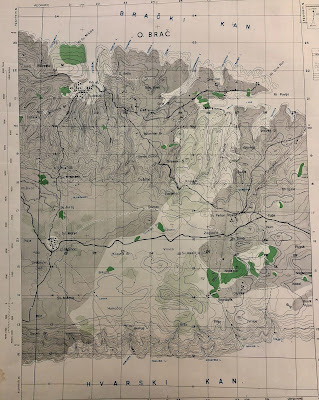One of my local British army regiments is the Highland Light Infantry (HLI), which recruited mainly from Glasgow and the surrounding area. It was formed in 1881 and was amalgamated in 1959 to form the Royal Highland Fusiliers. Today, it is the 2nd Battalion of the Royal Regiment of Scotland. In WW2, the 2nd battalion served in East Africa and the Mediterranean, including Keren, the Western Desert and Sicily. They have a small museum in Sauchiehall Street, Glasgow.
 |
| HLI in the Western Desert 1942 |
In May 1944, the battalion was sent to the Adriatic island of Vis as part of the 2nd Special Service Brigade, a Commando formation tasked with defending the island and supporting partisan operations against the German-held islands and the Dalmatian coast. The HLI were trained specialists in mountain warfare and had mountaineering equipment, including cross-country ski boots. Private soldiers were called ‘mountaineers’ rather than fusiliers.
Most of the duties involved garrisoning the island, which also served as a naval base for MTBs and MGBs. It also had an airstrip on the only flat area of the island, used by bombers in trouble returning from raids in the Balkans and Spitfires in the ground support role.
 |
| The former airstrip is still visible today |
The regimental historian, Lt.-Col. L.B. Oatts was clearly not a fan of his regiment fighting with Communist partisans, ‘Somewhat strange comrades in arms for British troops, and speaking no civilised language’, who he described (wrongly) as being led by ‘Commissars’. He somewhat surprisingly failed to mention that they included women soldiers, good grief, whatever next!
 |
| An 'uncivilised' partisan commander, speaking Serbo-Croat! |
In addition to garrison duties, they took part in raids on the islands to support partisan operations. These would typically include elements of several units based on Viz. For example, 40 Commando war diary for 22 May 1944 (National Archives, DEFE 2/48) describes Operation Foothound, an attack on Mljet which included C Company of the 2/HLI. Mortar and MG platoons were dropped off into covering fire positions while the HLI seized the high ground, directed by partisan guides who unusually had limited knowledge of the terrain. The commandos worked around the enemy positions, garrisoned by 250 men in four strong points, and attacked after Spitfires had softened up the defenders. The outcome wasn’t very clear from the report, but McConville (Small War in the Balkans, 1986) says the raid commander, Brigadier Tom Churchill regarded it as a failure. Two strong points were destroyed, but the rock formations were hard work for the troops, and wireless conditions were poor. The operation was called off at 4:30pm.
In June, ‘B’ Company (five officers and 73 other ranks led by Major Brotherhood) attacked a German position at Nidova Gora on the island of Brac. This involved a four-mile approach march over limestone ridges carrying heavy loads. The partisan guides advised that the garrison numbered 40 men with two MGs and an 81mm mortar. The attack ran into fierce resistance, and the HLI suffered three dead, one missing and 14 wounded, which had to be evacuated after a seven-mile march across country.
Later, in what must be a pretty unique role for an infantry unit, they were tasked with boarding a German destroyer to capture or destroy it. Perhaps, fortunately, it was found to have run aground and abandoned. I suspect it was actually a smaller ship than a destroyer.
In July, they took part in a more extensive operation against the port of Split. They attacked German positions in the hills above the town, supported by naval gunfire. What the partisans, never mind the Germans, thought of the bagpipers is anyone’s guess. Although apparently came in useful to help the partisans and the Germans distinguish the HLI from other units and civilians. The HLI lost eight dead and 12 wounded in the operation, which achieved its objectives.
Most operations were more minor patrols on the nearby islands, including Solta, Brac and Korcula, popular holiday destinations today. But in 1944, this was a desperate and vicious war against well-entrenched defenders. As the Commando war diaries make clear, it wasn't unusual for patrols to decide that positions were too strong to attack.
 |
| A British wartime map of part of the island of Brac |
These operations are small enough to wargame on the tabletop with Bolt Action sized forces. The Germans typically fortified the high points on the islands. Attacks landed at night and typically began the assault at first light.
 |
| British commandos |
Great post- plenty of skirmish gaming to be got from there.
ReplyDeleteCheers,
Pete.
Thanks. From small patrols to company level and sometimes slightly larger. Plus the combination of sea, air and land operations.
DeleteAn interesting post on an area of the war that I knew nothing about. Perfect for small scale actions as you say on the wargames table.
ReplyDelete